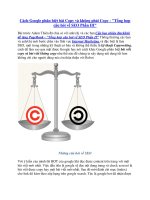facilitation trainingparticipant copy 27780
Bạn đang xem bản rút gọn của tài liệu. Xem và tải ngay bản đầy đủ của tài liệu tại đây (215.51 KB, 90 trang )
Facilitation
Skills
Learning Objectives
.To understand the roles of
facilitators
.To understand the facilitator’s
basic responsibilities
.To understand the structure
of facilitation map
.To understand the basic facilitation
skills
Program Outline and
Timelines
1.Getting Started – 30 minutes
2.Basic Responsibilities of a Facilitator
– 120 minutes
3.Basic Facilitation Map – 60 Minutes
4.The Facilitation Techniques – 180
minutes
❙ 5.Conclusion – 30 minutes
❙
❙
❙
❙
❙
Timetable
8.30 am – 9.00 am
9.00 am – 10.00 am
10.00 am- 10. 15 am
10.15 am – 11.15 am
11.15 am – 12.15 pm
12.15 pm – 1.15 pm
1.15 pm – 3.00 pm
3.00 pm – 3.15 pm
3.15 pm – 4.30 pm
(II)
4.30 pm - 5.00 pm
Getting started
Basic Responsibilities (I)
Break
Basic Responsibilities (II)
Basic Facilitation Map
Lunch Break
Basic Facilitation Techniques (I)
Break
Basic Facilitation Techniques
Conclusion
Module 1 Getting Started
Getting Started
Simple term
Facilitation means to
“Make Easy”.
This course is designed to
help teach people how to make
it easy to have productive
events and meetings.
Module 1 Getting Started
1. What do you think a
facilitator is?
The Role of Facilitator
The facilitator’s task is to ensure that
a team
a. avoids the potential disadvantages and
b. experiences all of the advantages
and so performs as a synergistic team
creating
excellent outcomes
2. Why is facilitator essential for long
term success?
a.Enhance process behaviors in fast
paced
environment which encourage
people to think and discuss before
implementing something
b.Bring about the positive aspect of
team development which will results
high synergy, productivity and
teamwork.
Business Environment
3. Today’s fast paced
business environment
bring about task
behaviors. (read notes)
Task behaviors
•
•
Doing
Work Independently
Making logic-based decisions
Acting
Moving things along
Focusing on details
Directing
Bringing things to closure (making decisions)
Controlling
Telling
Focusing on the job at hand
Resistance to change
Do it first
Do it first
Process Behaviors
Thinking,
planning
optimum
discussion and
are needed for
productivity.
Process Behaviors
❘
Thinking
Participating/teamwork
Using creativity and intuition
Talking
Exploring ideas more deeply
Focusing on the big picture
Facilitating
Opening up/looking for other ideas (generating
alternatives)
Letting go and empowering
Asking
Focusing on the people, values, and vision
Receptivity to change
Process Behaviors
Facilitator provides the
structure that encourage
process behaviors that
emphasis on thinking,
discussion and planning
together.
4. Working In a Team
Advantages
Disadvantages
Synergy or Dysfunction?
Role of Facilitator
+
Experience all the advantages Avoid the potential disadvantages
Synergistic team
Excellent Outcomes
Equation
In a Dysfunctional Team
2 + 2 = 3 or less
In a Synergistic Team
2 + 2 = 4 or more
The Role of Facilitator
Role of Facilitator
+
Experience all the advantages Avoid the potential disadvantages
Synergistic team
Excellent Outcomes
The Role of Facilitator
The facilitator’s task is to ensure that
a team
a. avoids the potential disadvantages and
b. experiences all of the advantages
and so performs as a synergistic team
creating
excellent outcomes
Conclusion
Facilitator is essential for today’s business
in two aspects:
a. It helps the team to focus on process
behaviors, that is planning, thinking and
discussion
b. It helps the team to bring out the best
part of team to be more synergistic.
Komag’s Definiotion
❚ The definition of facilitation
Komag’s SDWT Context
❚ Facilitator is the individual
who designs and manages of
structures and processes that
help a group do its work and
minimize the common problems
Core Processes of Facilitation
1.
Analyzing Information to determine
the best approach
2. Designing Meeting (Facilitation
Map)
3. Establishing group climate, norms
and roles with the team (Ground
Rules)
4. Creating and implementing
structures and processes to
accomplish tasks and meet objectives
Core Processes of Facilitation
5.
6.
7.
8.
Intervening to manage group dynamics and
to influence what members are doing or how
they are doing it (Basic Facilitation
Skills)
Coaching team leaders and team members in
effective behaviors
Evaluation meeting and facilitation
effectiveness to enhance team learning
(Facilitator Feedback)
Ensuring follow-up action related to
production, meeting, results, communication
and implementation of decision.
Module 2
Introduction to the Basic
Responsibilities of a
Facilitator









